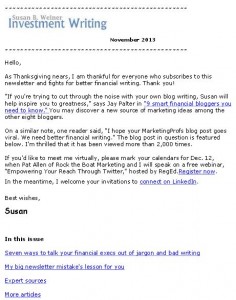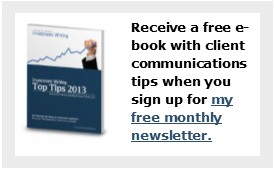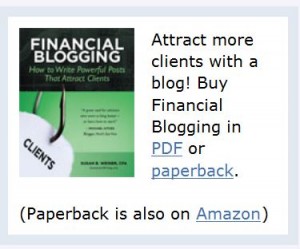Stop being happy–and win more readers
Does the following sentence inspire you to dig into the writer’s newsletter?
The XYZ Financial team and I are happy to bring you this month’s newsletter.
It doesn’t inspire me. I doubt it inspires you. However, I often see financial professionals start their emails, letters, and newsletters with similar sentences. If they’re not “happy,” they’re “pleased,” “delighted” or something similar. This is so wrong. Stop being happy!
Why to stop being happy
 Please stop talking about how great your content makes YOU feel.
Please stop talking about how great your content makes YOU feel.
Unless you’re writing to close family members or friends, no one cares about your emotions. They care about WIIFM—what’s in it for me, your reader. When you talk about your happiness you sacrifice the opportunity to appeal to their WIIFM.
In addition, focusing on YOUR emotions may make you seem self-centered or self-important. It’s as if you’re saying, “We are great. Bow down at our feet and worship us.” Okay, I’m exaggerating. Still, I hope you get the idea that I’m trying to communicate.
Your alternative to being happy
How else can a writer open their message? Start with something that solves a problem that your reader has. This will appeal to their WIIFM.
For example:
Curious about how the new tax law affects you? Avoid problems with the IRS by learning about the three things you may need to do differently, as covered in this month’s newsletter.
In addition to focusing on the reader’s WIIFM, this new introduction also gets to the point quickly. That’s essential to grabbing the attention of readers whose email inboxes are overcrowded.
Not sure how to identify your unhappy topic?
If you have trouble identifying your readers’ problems, read “Identifying ‘WHAT PROBLEM does this blog post solve for them?’” The same issues apply to blogs and newsletters. In fact, today’s newsletter articles often originate as blog posts.
Stop being happy and start attracting more readers and clients!
Image courtesy of stockimages/FreeDigitalPhotos.net





